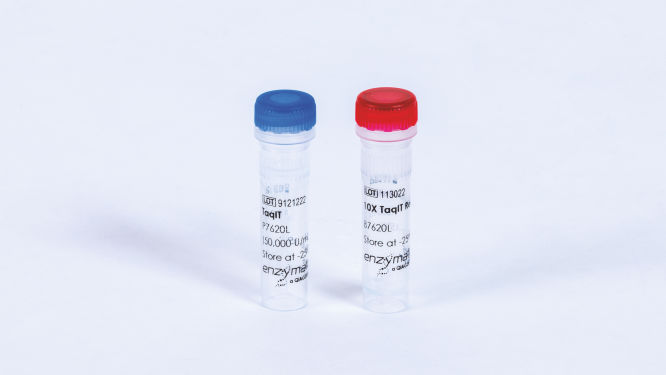Cat. No. / ID: P7620L
Features
- Exonuclease-deficient derivative of Taq DNA Polymerase
- More thermostable and greater fidelity than full-length Taq DNA Polymerase
Product Details
TaqIT DNA Polymerase is an exonuclease-deficient derivative of Taq DNA polymerase.
The enzyme is supplied in 20 mM Tris-HCl, 222 mM (NH4)2SO4, 10 mM β-mercaptoethanol, 0.1 mM EDTA, 0.1% Brij 58 and 50% glycerol; pH 8.6 at 25°C.
The 10x TaqIT Reaction Buffer contains 500 mM Tris-HCl, 160 mM (NH4)2SO4, 35 mM MgCl2 and 0.25% Brij 58; pH 9.2 at 25⁰C.
Performance
- Storage temperature: –25°C to –15°C
- Molecular weight: 62,407 Daltons
| Test | Units tested | Specification |
|---|---|---|
| Purity | n/a | >99% |
| Specific activity | n/a | 42,000 U/mg |
| Single-stranded exonuclease | 500 | <1% released |
| Double-stranded exonuclease | 500 | <1% released |
| Double-stranded endonuclease | 500 | No conversion |
| E. coli DNA contamination | 500 | <10 copies |
Principle
TaqIT DNA Polymerase is an exonuclease-deficient derivative of Taq DNA polymerase. TaqIT DNA Polymerase lacks the first 280 amino acids of native Taq polymerase that contain the 5ʹ→3ʹ exonuclease domain. This deletion makes the TaqIT enzyme slightly more thermostable and has slightly greater fidelity than the full-length Taq enzyme. Like Taq polymerase, TaqIT DNA Polymerase has no inherent 3ʹ→5ʹ exonuclease activity.
A recombinant E. coli strain carrying the TaqIT gene from the thermophilic organism Thermus aquaticus YT-1.
One unit is defined as the amount of enzyme that will incorporate 10 nmol of dNTP into acid-insoluble material in 30 minutes at 75°C.
Procedure
Usage instructions
Set up the following reaction mixture in a total volume of 50 µL
| Component | Volume (µL) | Final concentration |
|---|---|---|
| Nuclease-free H2O | x | N/A |
| 10x TaqIT Reaction Buffer (B7620) | 5 | 1x |
| 10 mM dNTP mix | 1 | 200 µM each |
| Primer 1 | x | 0.2 µM |
| Primer 2 | x | 0.2 µM |
| DNA template | x | < 1000 ng |
| TaqIT (P7620L) | 0.1–0.5 | 5-25 U |
Note: Volumes can be adjusted as needed.
Cycling conditions
| Step | Temperature | Time | Cycles |
|---|---|---|---|
| Initial Denaturation | 94°C | 30 s – 3 min | 1 |
| Denaturation | 94°C | 30 s | 25–40 |
| Annealing | 50–65°C | 30 s | |
| Extension | 72°C | 60 s/kb | |
| Final Extension | 72°C |
5 minutes hold |
1 |
| 4°C |
Note: Cycling conditions may need to be optimized depending on the amplicon of interest.
Quality Control
Specific activity was measured using a two-fold serial dilution method. The enzyme was diluted in a reduced-glycerol (5%) containing TaqIT DNA Polymerase storage solution and added to 50 µL reactions containing calf thymus DNA, 25 mM TAPS (pH 9.3), 50 mM KCl, 1 mM DTT, 3H-dTTP and 100 µM dNTPs. Reactions were incubated for 10 minutes at 75°C, placed on ice, and analyzed using the method of Sambrook and Russell (Molecular Cloning, v3, 2001, pp. A8.25-A8.26).
Protein concentration is determined by OD280 absorbance.
Physical purity is evaluated by SDS-PAGE of concentrated and diluted enzyme solutions followed by silver-stain detection. Purity is assessed by comparing the aggregate mass of contaminant bands in the concentrated sample to the band's mass corresponding to the protein of interest in the diluted sample.
Single-stranded exonuclease is determined in a 50 µL reaction containing a radiolabeled single-stranded DNA substrate and 10 µL of enzyme solution incubated for 4 hours at 37°C.
Double-stranded exonuclease activity is determined in a 50 µL reaction containing a radiolabeled double-stranded DNA substrate and 10 µL of enzyme solution incubated for 4 hours at 37°C.
Double-stranded endonuclease activity is determined in a 50 µL reaction containing 0.5 µg of plasmid DNA and 10 µL of enzyme solution incubated for 4 hours at 37°C.
E. coli contamination is evaluated using 5 µL replicate samples of enzyme solution that are denatured and screened in a TaqMan qPCR assay for the presence of contaminating E. coli genomic DNA using oligonucleotide primers corresponding to the 16S rRNA locus.
Applications
This product is available for molecular biology applications such as:
- Longer PCR products than standard Taq polymerase
- Genotyping
References
- Barnes WM. (1992)The fidelity of Taq polymerase catalyzing PCR is improved by an N-terminal deletion. Gene 112:29.
- Karantzeni, I., Ruiz, C., Liu, CC., Licata, V.J. (2003) Comparative thermal denaturation of Thermus aquaticus and Escherichia coli type 1 DNA polymerases. Biochem J. 374:785.

